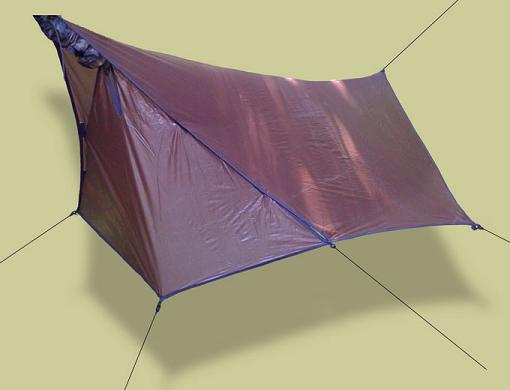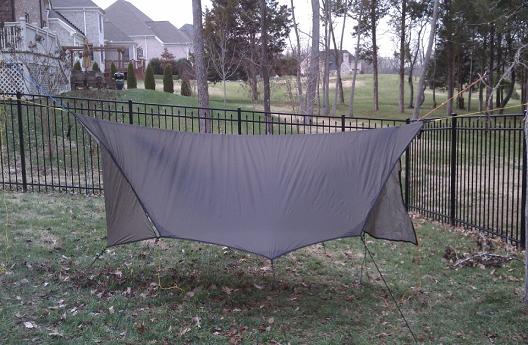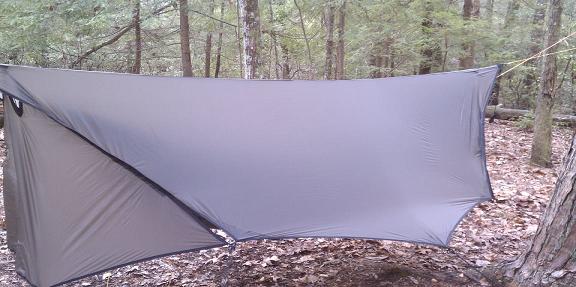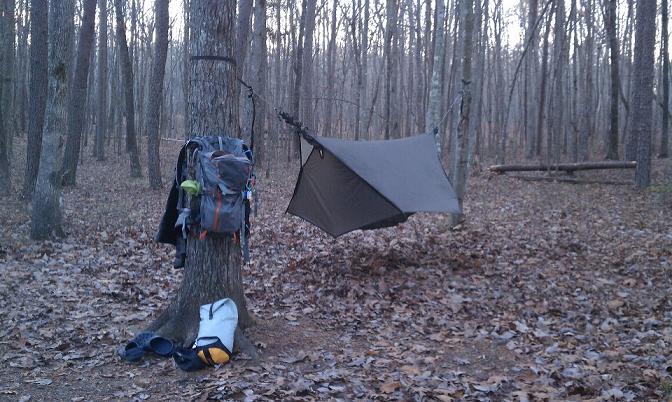|
HENNESSY MONSOON RAINFLY 30D SILNYLON
BY STEVEN M KIDD
OWNER REVIEW
April 10, 2012
TESTER INFORMATION
|
NAME:
|
Steven M Kidd
|
|
EMAIL:
|
ftroop94ATgmailDOTcom
|
|
AGE:
|
39
|
|
LOCATION:
|
Franklin, Tennessee
|
|
GENDER:
|
M
|
|
HEIGHT:
|
5' 9" (1.75 m)
|
|
WEIGHT:
|
220 lb (99.80 kg)
|
Backpacking Background: I've been a backpacker on and off for over 25 years. I backpacked as a Boy Scout, and then again almost every month in my twenties, while packing an average weight of 50+ lbs (23+ kg). In the last several years I have become a hammock camping enthusiast. I generally go on one or two night outings that cover between 5 to 20 mi (8 32 km) distances. I try to keep my pack under 20 lb (9 kg) even in the winter.
PRODUCT INFORMATION
 | | Image Courtesy of Hennessy Hammock |
Manufacturer: Hennessy Hammock
Year of Manufacture: 2011
Manufacturer's Website: http://hennessyhammock.com
MSRP: US $109
Listed Weight: 18 oz (510 g)
Measured Weight: 18 oz (510 g)
Color: Coyote Brown
Fabric: 30D Silicone Nylon 66 Ripstop
Dimensions: asymmetric hexagon 85 x 120 in (216 x 305 cm)
{Also available in 70D Polyester, colored Hunter Green, with a Listed Weight of 21 oz (610 g) at an MSRP of $79.95}
The Hennessy Monsoon Rainfly is an all-weather shelter for hammock campers. The product is designed in an asymmetric hexagonal shape and is designed to protect hammocks, specifically Hennessy Hammocks, from the elements. Most Hennessy hammocks are designed in an asymmetric cut to allow for a diagonal lie in the product. This differs from many gathered end hammocks are basically a simple rectangular piece of fabric when disassembled.
This rainfly (also referred to as a tarp) is made with 30 Denier silicone impregnated Ripstop Nylon, known colloquially as silnylon. It has removable doors on each end of the shelter which the company refers to as Blast Panels. The design is intended to allow the hammock camper the flexibility of removing the panels in fair weather and hunkering down with them attached when conditions are more severe.
BACKGROUND INFORMATION & FIELD USE
I have used the Hennessy Monsoon throughout the late summer and into the recent winter season for a minimum of 16 nights in the backcountry. Temperatures have ranged from 20 - 90 F (-7 - 32 C) with both dry and rainy conditions. Because wind conditions can adversely affect hammock camping comfort, I will mention that at times there was absolutely no wind and at others there were gusts as high as 20 mph (32 km/h).
Much like tent campers need a rainfly to shield the tent body from foul weather and the elements, so does the hammock camper. Hammock rainflys are available in many shapes and sizes. A few popular choices are catenary cut hexagonal tarps, as well as asymmetrical ones. This one is described as both a modified catenary cut asymmetrical "hex" fly. A catenary cut consists of a small arch shaped design in the fabric, which allows for a 'tighter pitch' when staking out or tying off the tarp. This is particularly helpful in a silnylon tarp. A hexagonal fly is basically that, one cut roughly in the shape of a hexagon.
 | | Silnylon 'Sag' Potential on the Monsoon |
The aforementioned silnylon allows for a lighter weight fabric per square yard/meter that is still waterproof. Along with the positive attributes of silnylon are a few drawbacks which include the ability for small amounts of water to penetrate the fabric in severe downpours and specifically if the tarp brushes against an object or the camper within the hammock. It also has a tendency to sag somewhat as conditions change if it isn't properly pitched. In the image to the left I was testing a new ridge line suspension system with the Monsoon and didn't achieve a tight pitch allowing for sag in the tarp. This is a perfect example of how not properly setting up the tarp could lead to a moisture problem.
Traditional guy lines have the ability to exacerbate this sagging issue. To combat this, Hennessy provides both traditional synthetic guys as well as those made of shock cord. The shock cord stretches allowing for some give and take as the atmosphere changes and thus allows the pitch to remain taut in changing conditions. I personally removed the traditional set of guy lines from the tarp and left only the shock cord version in an attempt to minimize unneeded weight. A nice feature on the rainfly is small built-in storage pockets for the guys when they are not in use. This particularly aids in minimizing tangling issues during storage and transport.
The fly itself has six tie-out points...three on each side. Each corner has a tie down point, and there is also a centralized tie down point on each side of the Monsoon. This is where both the catenary (cat-cut) and the asymmetrical (asym) come into play. There are two curves between the corners of the tarp and the center tie down on each side. The asym is due to the fact that centralized tie outs are slightly off center. The asymmetric design isn't completely noticeable in the accompanied images, but the cantenary cuts are distinct in my opinion.
 | | Notice the Cat Cuts & the Blast Panels |
The end doors, or blast panels are the feature that really sold me on acquiring the Monsoon. High winds have the potential to allow rain to enter underneath the tarp in a sideways fashion. Also, even in the absence of rain, high winds can negatively affect comfort and warmth inside a hammock. I decided to purchase this product to protect my hammock from both these elemental issues. In fair weather these panels are completely removable. They attach to main portion of the tarp with two strips of hook-and-loop and a system of mitten hooks, toggles and rings. Each door weighs 2.5 oz (71 g), and one or both can be removed from the main part of the fly. Thus if both doors are removed and left at home for a fair-weather trip the fly would only weigh in at 15 oz (425 g). Each door also has a tie down, so when they are deployed there are a total of eight tie down points for the Monsoon.
Generally I'm comfortable enough with hanging my hammock and pitching my tarp to eliminate the aforementioned rain issue, even in moderate to windy conditions. I simply set up the tarp in a cross wind direction so rain won't enter through the ends of the hammock. This generally suffices unless there are severe wind shifts. However, I really enjoyed the doors for wind protection during winter camping. Wind and air flow that encircles the hammock has the opportunity to create an environment that will chill a hammocker. These doors, along with a down top and under quilt, both cut down on some of this and created a shelter that allowed my own body heat to remain within the mini ecosystem to stay warm on nights that were well below freezing. On cool nights I tended to hang my hammock low to the ground and set the bottom edges of the tarp around 12 - 18 in (30 - 46 cm) off the ground. This minimized cool air flow. This, however, is one drawback to the Monsoon. With a width of 95 in (216 cm), I found it difficult to pitch the tarp really close to the ground without having my hammock under quilt drag on the ground. My under quilt is down, and even with DWR I wouldn't want it touching the ground all night long. I have a tarp that is 120 in (305 cm) wide that allows me to pitch the tarp all the way to the ground while still allowing my hammock to hang well above the ground and it still gives me plenty of head room above. The image above represents a lower to the ground pitch, whereas the one below the tarp is pitched higher in less threatening weather.
 I've really come to enjoy the Hennessy Monsoon. I like the flexibility of the tarp offers. I can carry the tarp and end panels when needed, or remove the doors and leave them at home to save some pack weight if I'm not expecting extreme weather. It gave me superior coverage in dry and windy weather, cold and wet rain and below freezing temperatures. I personally have never experienced moisture seepage as mentioned earlier in the report, but if I were to suggest improvements on the Monsoon it would be to add pullouts midway along the center of the tarp body. These pullouts, which are available on several competing tarps, would allow me to guy out the center of the tarp to pull it away from the hammock body to ensure I don't accidentally brush against it in both normal and particularly high wind conditions. I'd also think adding an additional 20 in (50 cm) to the width of the fly could be a potential improvement. The positive result would be that I could set the tarp closer to the ground in inclement weather, but along with that would come the negative of added weight. To be honest, I'm a little torn on that suggestion. Hennessy also produces a model called the Typhoon that is 5 in (13 cm) wider and it adds an ounce (28 g) to that tarp. I can't be certain, but I can deduce that a fly of that size would in my opinion add substantial weight. A fly made of SpinnTex could potentially add coverage and minimize added weight. I've really come to enjoy the Hennessy Monsoon. I like the flexibility of the tarp offers. I can carry the tarp and end panels when needed, or remove the doors and leave them at home to save some pack weight if I'm not expecting extreme weather. It gave me superior coverage in dry and windy weather, cold and wet rain and below freezing temperatures. I personally have never experienced moisture seepage as mentioned earlier in the report, but if I were to suggest improvements on the Monsoon it would be to add pullouts midway along the center of the tarp body. These pullouts, which are available on several competing tarps, would allow me to guy out the center of the tarp to pull it away from the hammock body to ensure I don't accidentally brush against it in both normal and particularly high wind conditions. I'd also think adding an additional 20 in (50 cm) to the width of the fly could be a potential improvement. The positive result would be that I could set the tarp closer to the ground in inclement weather, but along with that would come the negative of added weight. To be honest, I'm a little torn on that suggestion. Hennessy also produces a model called the Typhoon that is 5 in (13 cm) wider and it adds an ounce (28 g) to that tarp. I can't be certain, but I can deduce that a fly of that size would in my opinion add substantial weight. A fly made of SpinnTex could potentially add coverage and minimize added weight.
Overall, I've been impressed with this Hennessy product, even with the minor thorns I just mentioned.
I've used three different hammocks with successful coverage. One was a Hennessy Deep Jungle, and that would be expected, but it also gave me fine coverage with both a Grand Trunk Ultralight and a Warbonnet Blackbird. The product was designed to work in tandem with Hennessy products, but I found it worked well with competing brands as well. That versatility is another rose for the Monsoon, and another reason I'm happy I've purchased this quality rainfly.
This report was created with the BackpackGearTest.org Report Writer Version 1.5
Copyright 2012. All rights reserved.
Read more reviews of Hennessy gear
Read more gear reviews by Steven M Kidd
|




